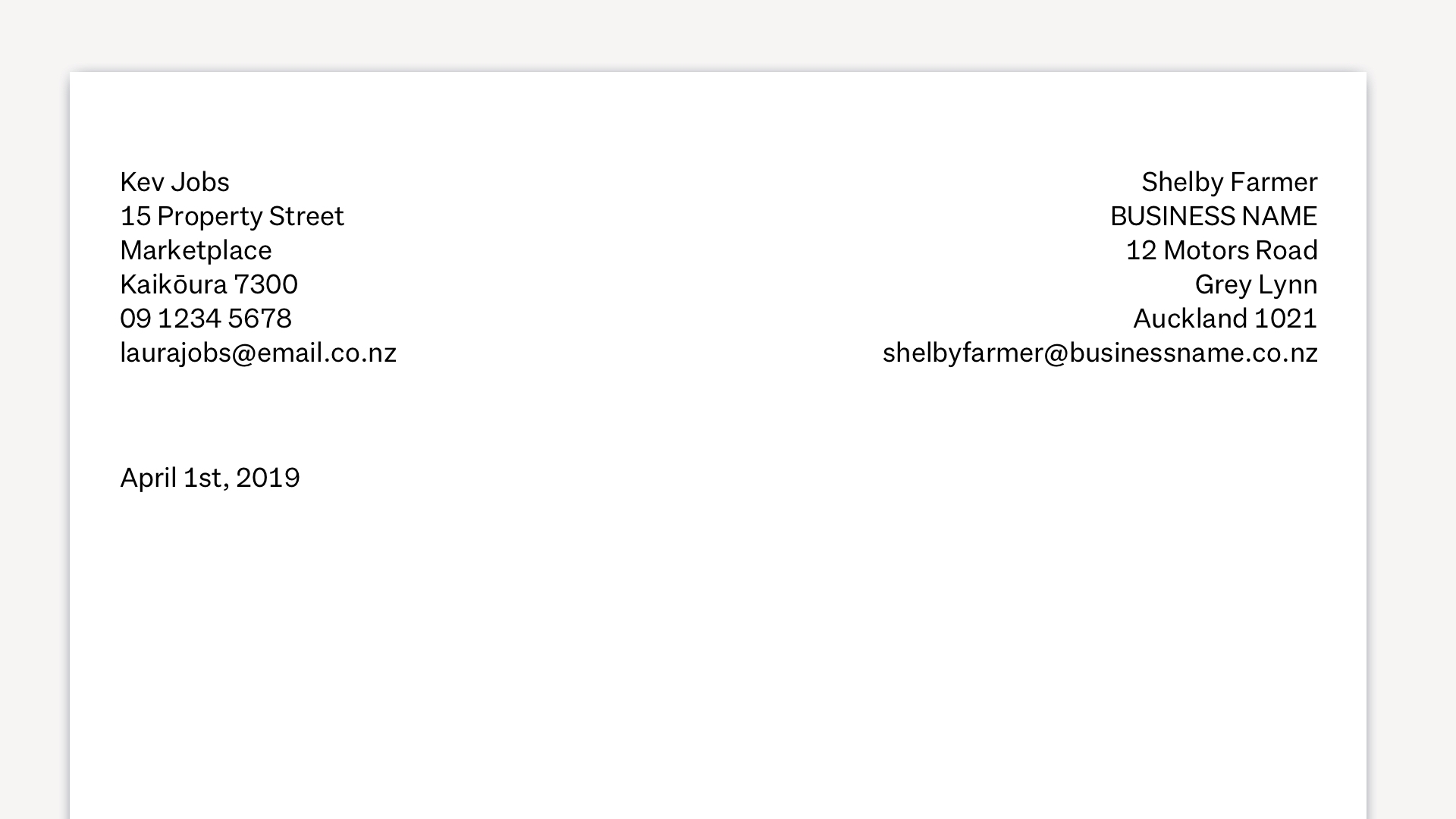Careers advice
How to write a cover letter for your first job in New Zealand (with templates)
Writing a great cover letter for your first job can be tough. But these tips will get you on the right track.
What you’ll learn:
- What are cover letters?
- The importance of cover letters
- Tips for creating your first cover letter
So, you’re wondering how to write a cover letter for your first job.
Good on you.
In New Zealand, these documents aren’t optional extras on top of a CV – they’re a vital part of showing you’re the right person for the job. By submitting one, you’re putting yourself on the front foot, which is what successful job hunting is all about.
However, first cover letters aren’t easy – especially if you lack experience. To help, we’ve created this step-by-step guide on what to include, where and why. Let’s get cracking. We’ve also got a sample cover letter you can download and use for yourself when applying for jobs.
Writing an entry level cover letter doesn't have to be stressful.
What are cover letters?
A cover letter is a document you submit along with your CV when you apply for a job. In New Zealand, cover letters should be no longer than one page, and should aim to highlight your interest in the job, as well as why you’re the right person in terms of your previous skills and experience.
Why are cover letters important?
You might be asking yourself, ‘why do I need to submit a cover letter as well as a CV?”. Well, the two documents should complement each other, and neither is effective in isolation as they are together.
On a CV, you should present your key skills and experience in short snappy bullet points that are easy for the reader to digest. A cover letter provides you the space to expand upon your CV, and the first opportunity for the hiring manager to get a handle on who you are and what you’re about. For this reason, you need to make sure that your cover letter underlines your most attractive skills and experiences so that there’s no way the reader will miss them.
In addition, unlike a CV, which should be entirely focussed on you, a cover letter needs to explain why you’re interested in the job, and the company advertising it. Importantly, employers don’t just want to hear how skilled you are, they also want to know that you’re looking for more than just a salary. In other words, you need to explain why this role/organisation speaks to you, and why you want to work there, as opposed to simply anyone who will offer you a job.
What’s more, a cover letter in itself shows interest. Anyone can keep the same CV on file and throw it in to any employer who’s advertising a job. However, a cover letter is more personal, and employers know they take longer to write. Therefore, if you only submit a CV, and someone submits a CV and a cover letter, guess who looks more interested from the employer’s perspective?
Tips for creating your first cover letter
1. Your details
You’ll probably submit your cover letter online, but still format it like a real letter. This means starting with:
- Your full name, contact details and home address
- The date you submit the application
- The business’ postal address
Start your cover letter like this.
Top tip: Don’t put this info into a document’s header. Many employers use applicant tracking systems (ATS) to initially scan cover letters for important details, and sometimes this software can’t read headers.
2. Introduce yourself
You should address the cover letter to a real person. This is an important personal touch that can help you stand out, and the hiring manager’s or recruiter’s name is usually given in the job listing.
If there’s no name given, check the company’s staff page and find someone (like a department head) to address it to. Even if this isn’t bang on, it shows you made the effort.
As a last resort, ‘Dear Hiring Manager’, will do the trick.
Now, there are several ways you can start your cover letter. The style you choose will largely depend on your personality, and the role you’re going for – e.g. an application for a graphic design role can probably be more creative than one for a dentist’s assistant. However, any good intro will include:
- The job title – Note: make sure you capitalise it
- Where you saw it
- A snappy one liner describing yourself
- A teaser of what you would bring to the role to get them interested
Example 1:
“Dear Kohia Smith,
I’m writing to apply for the reporter role you’re currently listing on Trade Me Jobs. I’m a recent communications graduate with an interest in community news and digital-first reporting. I’d love to join your team and find stories that will engage and grow your readership.”
Example 2:
“Dear Richard Hall,
I’m really excited about the Labourer position you’re currently listing on Trade Me Jobs. I’m a hard-working and highly motivated high-school graduate, keen to begin a trades career. I’d love the opportunity to join your team and develop my skills.”
Personalise your cover letter by addressing it to a real person.
3. Your skills, qualifications and attributes
Don’t worry, you can write this section of your cover letter with no experience in the field you’re applying for.
Here, you can include:
- Uni or highschool qualifications
- Volunteer experience, unpaid internships, temporary summer jobs
- Personal qualities that make you a great fit for the role
Whatever you go with, make sure to:
- Be specific
- Tie it back to the role’s requirements
Example 1:
“My BA in Communications Studies gave me a firm grounding in media ethics and law, and also taught me how to find, research and publish stories across platforms ranging from print to social.
I built on this with work experience at NEWSPAPER NAME last summer. As well as shadowing their reporters, I sat in on production meetings to learn how the editors decided which stories to pursue, and what formats they thought were most appropriate”.
Example 2:
“Holiday work in my local Four Square means I’m used to completing long shifts, remaining professional and proactive throughout. This job also emphasised communication, teamwork and problem-solving to make sure the store always met customer expectations.
I’m also physically fit, as I train with my rugby team twice a week and play a match every weekend. On top of this, I have a full, clean driver’s licence and my own transport”.
If you’re struggling to decide what skills or qualifications are most relevant to the position, a good first step is creating a Trade Me Job Profile. This tool can create a template CV based on your experiences and qualifications, which you can use as inspo for your cover letter. What’s more, Trade Me Job Profiles allow employers to approach you with opportunities you haven’t found.
Here are some tips on what Kiwi bosses want from new employees.
4. Why you’re a great fit
By now, the reader knows what you bring to the table, so it’s time to seal the deal.
You can approach this section by:
- Showing passion for their business or industry: only do this if you can make it genuine. Hint: saying you’ve always dreamt of working for a local cafe is a tad unbelievable (even if it’s true).
- Showing your eagerness to learn: this is great for entry level cover letters. Attitude goes a long way, and employers love enthusiasm and ambition.
- Talk about your values: companies today are very values driven. Showing your personal principles align with theirs suggests you’ll be a good fit.
Example 1:
“I now want to take my skills and experience into a fast-paced, 21st century news environment. As a longtime reader of NEWSPAPER NAME, I admire your commitment to balanced storytelling, and the way you’ve adapted to the digitalisation of news reporting,”
Example 2:
“The role appeals to me because I see lots of opportunities to gain new technical skills, due to the wide variety of commercial and residential projects the company takes on. I’m also keen to develop my interpersonal skills, as this is crucial to my long term ambition of managing a team of labourers in the future.”
5. End with a call to action
What do you want from your application? A job interview.
This final section is where you confidently (but politely) prompt the reader to get in touch and set up the next step.
Example 1:
“I believe I have the skills and experience needed to hit the ground running in this role, and I would be thrilled to join your team. Thank you for considering my application, and I look forward to hearing from you.
Yours sincerely,
Rebecca Clarke.”
Example 2:
“I believe my past experience, attitude, and willingness to learn would make me a great fit for this role, and I would be thrilled to join your team. Thank you for considering my application, and I look forward to hearing from you.
Yours sincerely,
Bradley Brown.”
And voila, one cover letter.
Other articles you might like




